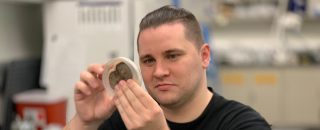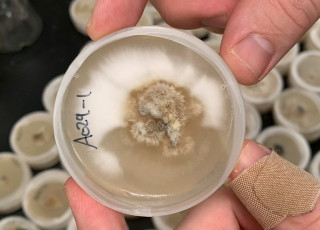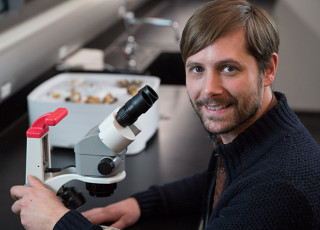The Hidden Potential of the World’s Biggest Organism
Graduate student Alex Bradshaw inspects a live sample of the tree-eating fungus Armillaria in the genetics lab at the Natural History Museum of Utah. Photo © NHMU.
By Kendra Autumn
A hungry monster miles wide lives and feeds in central eastern Oregon. You can’t see the monster itself, it dwells beneath the ground. You can only see the damage it’s done.
Armillaria, the honey mushroom, is a parasite that preys on conifers and hardwoods, and Oregon’s Malheur National Forest is home to the biggest known Armillaria in the world. This individual fungus, colloquially known as the Humongous Fungus, is also thought to be the biggest organism in the world, period. Yet, the only visual evidence of its presence is more than three square miles of dead and dying trees. Pieces of the same Humongous Fungus are also growing in Petri dishes at the Natural History Museum of Utah.
When I think about a giant mushroom--the biggest organism in the world--I imagine a spongy stalk taller and thicker than a skyscraper, towering height topped with a ponderous cap the size of a parking lot. However, in reality, this giant is much subtler than that. Mushrooms we see poking above the leaf litter or sprouting out of logs are actually just the fruiting body of the fungal organism, kind of like how a flower is just one temporary part of the whole plant. A fungus’s true, secret identity is as a network of “roots” one cell thick that grow immersed in a substrate such as soil, wood, or dung. These delicate white “roots” are called hyphae and one fungus’s mass of hyphae is called a mycelium. The patch of dead trees visible aerially in Malheur is evidence of Armillaria’s mycelium spreading underground and attacking trees for their nutrients. In fact, the Humongous Fungus has never been known to produce mushrooms, meaning that there is no evidence that it’s reproducing sexually.
It’s easy to picture Armillaria as an overpowering blight sweeping a landscape, choking out trees and leaving the forest withered and ruined, a sort of ecological antagonist. In reality, the parasite is a natural part of the ecosystem it inhabits, and, not only that, also has potential relevance to cancer research.
The connection between a rapacious fungal tree-killer and human medicine may not seem obvious, but Alex Bradshaw is good at seeing connections in unusual places. Alex is a PhD student at the University of Utah in the Molecular, Cell, and Evolutionary Biology program. He’s doing his graduate work in Dr. Bryn Dentinger’s fungal genetics lab, located at the Natural History Museum of Utah. Bryn is the museum’s Mycology Curator and also holds a joint appointment as an Assistant Professor at the University of Utah.
Last fall, Alex traveled to Malheur National Forest to collect samples from the Humongous Fungus to culture and study in the lab. “Collecting samples” may sound like a delicate process, but in this case the tool of choice is a pulaski--a sort of axe with an implement for digging on the back of the head. Alex returned to Utah with large chunks of tree roots hacked from Armillaria’s unfortunate victims, the parasitic fungus concealed within the dirt-caked wood. These samples are planted into Petri dishes, tiny fragments of their monumental whole, fuzzy brown mycelia full of potential discoveries about the biology of a mysterious hidden giant. Alex will use these mini-Humongous Fungi to look for mutations that occur in some samples and not others, a phenomenon which could act as a parallel to the emergence and proliferation of cancer cells in animals.
Links like these between the natural world and human society demonstrate the importance of studying biodiversity. Efforts to better understand fungal biology and diversity have already resulted in the discovery of new medicinal compounds, innovative ideas for mitigating pathogens that threaten crop plants, resilient and eco-friendly materials grown from fungal mycelia, and more. We never know what we might find in an unexplored branch of the tree of life, and fungi are a promising frontier.
Kendra Autumn is a PhD student doing research at the Natural History Museum of Utah a part of the University of Utah in Salt Lake City. Our mission is to illuminate the natural world and the place of humans within it. In addition to housing outstanding exhibits for the public, NHMU is a research museum. Learn more.



